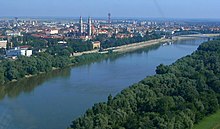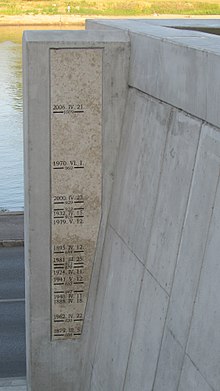Szeged
![]()
The title of this article is ambiguous. For other meanings, see Szeged (disambiguation).
Szeged [ˈsɛgɛd] ![]() (German Szegedin or Segedin, Croatian Segedin, Serbian Сегедин Segedin, Romanian Seghedin) is the third largest city in Hungary, with 160,766 inhabitants (2019). It is located on the southern border of the country at the border triangle with Serbia and Romania at the mouth of the river Marosh (Hungarian Maros) into the Tisza (Hungarian Tisza). The city is connected to the capital Budapest, about 170 km to the north, by the intercity railway and the M5 motorway. Szeged is the seat of Csongrád-Csanád County and has county rights itself. Over 2000 hours of sunshine per year - more than in any other city in the country - have earned Szeged the nickname "City of Sunshine".
(German Szegedin or Segedin, Croatian Segedin, Serbian Сегедин Segedin, Romanian Seghedin) is the third largest city in Hungary, with 160,766 inhabitants (2019). It is located on the southern border of the country at the border triangle with Serbia and Romania at the mouth of the river Marosh (Hungarian Maros) into the Tisza (Hungarian Tisza). The city is connected to the capital Budapest, about 170 km to the north, by the intercity railway and the M5 motorway. Szeged is the seat of Csongrád-Csanád County and has county rights itself. Over 2000 hours of sunshine per year - more than in any other city in the country - have earned Szeged the nickname "City of Sunshine".

Centre of Szeged at the Tisza
Geography
Geographical position
Szeged is located in southern Hungary and in the southern part of the Great Hungarian Plain on the lower reaches of the Tisza River, which flows into the Danube about 120 km south of Szeged on the territory of Serbia in Vojvodina. The Marosh River flows into the Tisza River at the eastern border of the city.
There are two larger and about 15 smaller lakes in the city area. The two large lakes (Fehér-tó and Sándorfalvi halastó) are located in the north of the city area. Some of the smaller lakes are artificial, e.g. for canoeing.
Neighbourhoods and districts
|
|
|
|
Neighboring communities
- Zsombó
- Szatymaz
- Algyő
- Domaszék
Climate
The climate is temperate continental with low rainfall, hot summers and cold winters. The coldest month is January (-1.4 °C on average), the warmest is July (+23.0 °C). With an average of 2100 hours of sunshine per year, the region around Szeged is the sunniest region in Hungary.
| Szeged | ||||||||||||||||||||||||||||||||||||||||||||||||
| Climate diagram | ||||||||||||||||||||||||||||||||||||||||||||||||
| ||||||||||||||||||||||||||||||||||||||||||||||||
| Monthly average temperatures and precipitation for Szeged
Source: WMO; wetterkontor.de | ||||||||||||||||||||||||||||||||||||||||||||||||||||||||||||||||||||||||||||||||||||||||||||||||||||||||||||||||||||||||||||||||||||||||||||||||||||||||||||||||||||||||||||||||||||||||||||||||||||||||||||||||||||||||||||||||||||||||||||||||||||||||||||

Aerial view: Szeged
History
The oldest signs in the area of today's Szeged and on the Tisza River come from mammoth hunters from the last Ice Age around 24,000 BC. The first archaeological findings date back to the Neolithic period around 5,000 BC.
Szeged was founded by the Romans and bore the name Partiscum. Excavations suggest that the Hun king Attila maintained a base here.
In Roman times, salt, gold and wood were transported on the water and land routes that still run through Szeged today. The Hungarians settled in Szeged after taking over the land in the 10th century. The first documented reference to the town dates back to 1183, when Szeged (Ciggedin) is mentioned as the centre of Hungarian salt transport. After Szeged was burnt down during the Mongol storm in 1241, the city was rebuilt and fortified with a castle. In the 13th century Szeged established itself as a trade centre especially because of its salt production.
In 1247 King Béla IV claimed Szeged as his own. In 1498 it was raised to the status of a royal free city. In 1526 it was sacked and burnt down by the Turks. The Turkish rule lasted 143 years and ended in 1686, when the town and the castle were reconquered by the Austrian imperial armies. During the struggle for freedom against the Habsburgs (1848/49), Szeged acted as the country's capital for a short time.
A catastrophic flood in 1879 destroyed 95% of the city. Of the approximately 6000 houses, only 300 were spared from the flood. The city was rebuilt with international help, with practically everything being planned and laid out anew. This explains the structure of the city's streets with rings and radiating paths. The ring roads today bear the names of the cities that helped in the reconstruction. With its uniform, eclectic cityscape, the palaces of the inner city and the spacious parks and squares, Szeged acquired the character of a modern European city.
After the flood, the citizens of Szeged made a vow: if their city was to be rebuilt, they would build a large church. In 1880, one year after the devastating flood, the decision was made to build. The foundation stone was laid in 1914, and the Cathedral of Our Lady of Hungary was completed in 1930. It is the fourth largest church in Hungary and the only cathedral built in Hungary in the 20th century. The Szeged open-air plays have been held on the cathedral square every year since 1931.
Around the turn of the century, a rapid upswing began in all areas. Trade and commerce flourished, schools were built, new offices and institutions were established. After the end of the First World War, Szeged and its surroundings were - in accordance with the Belgrade Agreement of 8 November 1918 - occupied by French troops in the strength of about 28,000 men from the spring of 1919. The occupation was maintained until 1929.
In 1921 the University of Kolozsvár (Cluj-Napoca), in 1923 and 1931 respectively the episcopal seat of the Csanád diocese was transferred from Temesvár, and in 1928 the Pest Pedagogical College was transferred to Szeged. The construction of the cathedral, started in 1913 and interrupted by the First World War, was finished in 1930.
After the Second World War, in which mainly the bridges had been destroyed, the renewed development of the town began. In the 1960s many new flats are built, the food industry (salami production, paprika processing, canning industry) became the most important industry of Szeged.
Today Szeged is a centre of economy, culture and sciences. With the recently united universities and colleges under one roof, as well as many high schools of different specialization, it is one of the five major study centers of Hungary. The number of pupils and students is equal to the population of a medium-sized Hungarian town. Apart from its open-air games organized in summer, international fairs, exhibitions and sporting events, Szeged is also well-known among gastronomy lovers.

Reök Palota in Szeged

Flood levels in Szeged



